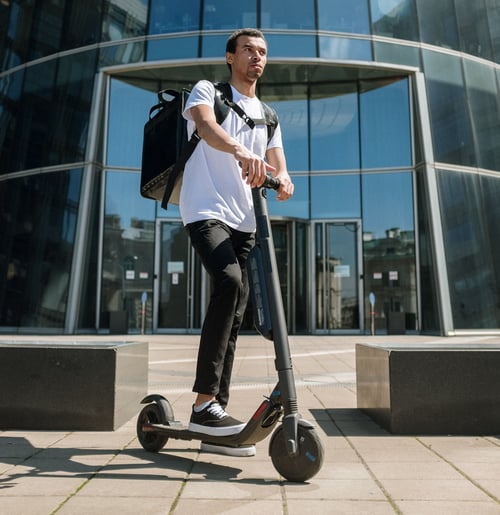Intertraffic speaks to seven players in the MaaS “game” to see how the global pandemic has affected them and their plans for a shared mobility future…
When the idea of Mobility as a Service was first mooted in the middle of the last decade, the very notion of the vast majority of the world losing its ability to be mobile was the last thing on anyone’s mind. Those responsible for any new product or solution, be it a selection of readily available mobility platforms or a new flavour of non-dairy milk, will have painstakingly run through what they believe are all the possible worst case scenarios and doom-laden eventualities before releasing it… but a global pandemic is almost certainly not one of them.
Just as MaaS solutions were starting to gain traction across the world, so COVID-19 struck and confined to their homes millions of potential customers (and of course existing customers) who had previously been looking to become increasingly mobile and have ready-made solutions at their fingertips.
As the global vaccine programmes continue to edge us slowly but surely towards a return to something like normality, Intertraffic was keen to discover how some MaaS practitioners and protagonists in Europe and the US were able to use the (somewhat still) fledging industry’s innate flexibility and agility to cope with an entirely unforeseen set of circumstances.
“I think that the whole transport sector has done quite an amazing job in supporting and keeping our critical services, cities and economies functioning during the challenging circumstances,” says Piia Karjalainen, General Secretary of the Brussels-based MaaS Alliance. “MaaS operators, often very tech-born and being the interface between users and mobility providers, are naturally in a very good position to understand and match the demand and supply, based on the preferences of the users and prevailing external circumstances. But also elsewhere in the transport sector we saw last year a bunch of new services and new kind of partnerships launched. Public transport operators and authorities introduced new measures to ensure safety of the fleets and new tools for the occupancy management.”
“I think that the whole transport sector has done quite an amazing job in supporting and keeping our critical services, cities and economies functioning during the challenging circumstances”
As described in some of our previous articles, the pandemic has created opportunities for dramatic re-thinks and even complete u-turns and, as a by-product, allowed OEMs, suppliers and authorities alike to expedite traditionally slow and cumbersome development processes, as Karjalainen explains.
“Shared mobility companies rolled out new services almost overnight that addressed the needs of critical workers and supported other sectors, like restaurants, keeping their businesses running. From IT companies we saw many new features for enhanced user information and capacity management. Although these services were brought to the market in the midst of the crisis I expect that many of them established themselves as permanent features - making us also better-equipped for the next disruption or crisis.”
Shared mobility: Flexibility vs. certainty of a vehicle
Talking of young, agile tech companies, Dutch multimodal mobility hub innovators Hely were able to react to the unprecedented change in circumstances at equally unheralded speed.
“COVID-19 has changed the way we travel completely, probably forever. This has a large impact on our company as a MaaS operator,” explains CEO Ingrid Staffhorst. “Honestly, when the pandemic started we thought we would be out of business in no-time as everyone was strongly advised to not leave their homes. However, we didn’t expect the outcome we experienced.
“People were actively looking for alternative methods of transportation. Shared e-bikes were no longer seen as a vehicle for lazy people or a temporary replacement for your own bike, but as a safe, healthy option for short trips instead of public transport. Besides that, for longer trips people replaced the train with a shared car. We especially noticed this during Christmas. People still wanted to visit their family, but wanted a safe way of transportation, so they opted for a shared eCar.”
“When the pandemic started we thought we would be out of business in no-time as everyone was strongly advised to not leave their homes. However, we didn’t expect the outcome we experienced.”
As a shared mobility provider, Hely naturally had to adapt to this new way of traveling. “So besides the obvious safety and hygiene measurements we took, including proper communication regarding the governmental guidelines, we also made it possible for more vehicles to be reserved in advance. Due to the Corona-measurements the Dutch government implemented, going out got less spontaneous: you need to plan ahead. So our users had less need for vehicles that they could take when they pleased, but desired the certainty of a vehicle when they needed it.”

(Photo: JéShoots, Pexels)
The Netherlands may not be the best example of how the new opportunities afforded by MaaS can be explored and exploited, as travelling by bike or public transport is second nature to millions of already receptive Dutch commuters. Tim McGuckin, former executive director of the now dormant MaaS America, suggests that in his home country the impact of MaaS in a post-COVID world could shake up the transportation establishment in a number of game-changing ways – and for a reason that, until recently, would have been entirely unthinkable. For the first time in the best part of 100 years Americans don't have that many solid reasons to get behind the wheel of their own cars. For a country that proudly proclaims to have been built on its automobile manufacturing roots, this is some kind of extraordinary shift in mindset.
“The modern daily commute in the US, from the 1960’s onwards, has done more to shape and define transportation infrastructure than any factor since the mass adoption of automobiles and, following that, the post-war combination of GI Bill/FHA policies that literally paved the way for the suburbs we know today. By ‘daily commute,’ it is important to know it is not the absolute number of commuter trips taken by people but the fact that commuter trips uniquely place high demand, across short periods of time, on limited facilities, as opposed to being more time and space distributed,” he insists.
“Because MaaS was conceived to address deficiencies in strategies and tactics deployed to manage travel demand, particularly commuter travel demand, to know the impact COVID-19 will have on MaaS, one should consider the fulcrum to be the work trip. We know all types of trips plummeted due to COVID. Some trip types were more inelastic – shopping, for example. Other types will explode due to pent-up demand (leisure). But even when conditions permit people to return to work, the same may not happen to the commute. Why? The pandemic has revealed that for a significant number of people, stay-at-home (or “remote”) work productivity is equal to or better than office productivity.”
“The pandemic has revealed that for a significant number of people, stay-at-home (or ‘remote’) work productivity is equal to or better than office productivity”
For Tom van Dam, Smart Mobility Project Manager at ITS Connekt in the Netherlands, if anything the ramifications for the mobility sector to not use this prolonged period of relative inactivity for good will be looked upon as a huge missed opportunity to change the perspective of shared mobility solutions. And, as with many transport- and transit-related arguments, it’s all about the data.
“In NL, we have fewer than 10,000 vehicles in shared car services, yet total personal vehicles registered exceeds 9,5 million. The market penetration of these services is still very modest, to put it mildly. Used car, bicycle, and motorcycle sales spiked, putting new pressure on parking spaces in cities and further congesting our streets. What is holding us back from including the personally owned car into the MaaS sphere? Many would say it has something to do with data.”
For some years OEMs have dominated the extraction of data from cars and the Netherlands is not in a powerful enough position to change it.
Says van Dam: “Consumers, presumably the owners of such data, have no say in the matter. Vehicle data is a ‘Wild West’ territory that consumers and politicians don't yet dare to touch for numerous reasons, but mainly because of the lack of knowledge and fear of unpredictable outcomes. Privacy and cyber threats are amongst our concerns. We have the ability to keep any unwanted visitors or potential spoilers of the party out of the data kitchen.”
Van Dam makes a passionate plea for the experiences of the past year to be put to good use by those with more than a vested interest in making a success of the pioneering Mobility as a Service work already undertaken.
“If no action is taken, the vehicle data gridlock puts us in an unpleasant situation that withholds the opportunity to add the personal car to the MaaS offering. This is a wake-up call for Europe to armour up and join the battle for MaaS. Now is the right time to act as we are facing the entrance of big tech companies into the car industry. When Apple comes to market with its iCar in 2024 it is reasonable to expect a user experience that is different from the way we experience cars today. If the music industry can serve as an example, then the possibility of an entirely new shared mobility ecosystem may be what is awaiting us.”
“If no action is taken, the vehicle data gridlock puts us in an unpleasant situation that withholds the opportunity to add the personal car to the MaaS offering”
Confidence in public transport
According to Aurélien Cottet, MaaS Project Leader at Transdev in Paris, it’s necessary to distinguish between the period of total confinement/lockdown and the period when people were allowed to move again with sanitary restrictions with the wearing of a mask and social distances.
“In the case of total containment, only essential workers had the right to move and under these conditions MaaS solutions were mainly used to make transport on demand and see what the possible options were, knowing that a certain number of mobility services had to shut down their operations. In the event that working life has resumed its course, MaaS solutions had to integrate important information for users, mainly vehicle capacity, dynamically updated traveler information, allowing users to better plan their journeys in all knowledge of causes.
“The positive side of this pandemic will have been the acceleration of the digitization of Public Transport operators, with the deployment of a contactless solution for payment and ticketing and real-time solutions for the arrival of buses, trains and other trams.”
Challenges of MaaS in a post-COVID world
One of the many benefits of being a young industry is that it isn’t weighed down by the habits and haunts of its past. There’s no “It’s never been done this way before” or “In the 1980s we…” within the confines of a MaaS discussion as there’s very little or indeed no ‘baggage’ to speak of. As MaaS Alliance’s Piia Karjaleinen points out, that isn’t to say that this vibrant, innovative sector isn’t without its own version of the challenges that more traditional industries have faced over the past year or so.
“With its expected positive impacts in making our transport system more sustainable and resilient, MaaS has the potential to be the game-changer in our everyday mobility. I anticipate that demand for solutions like MaaS is accelerating in post-COVID world. However, a challenge that the sector now faces is a low amount of investments channelled into the new mobility industry due to the fact that investors remain quite cautious, while waiting for clearer signals for the speedy and full recovery of our economies. Stimulus packages and strong, aligned policies from governments emphasising the urgency for green and digital solutions are now needed to help the sector through the funding gap that is hindering its capacity to innovate and invest and bring forward comfortable and smart mobility solutions for the future.”
Hely’s Ingrid Staffhorst maintains that the flexibility of MaaS solutions has, perhaps, opened the eyes of the travelling public to a new, convenient method of mobilization.
“People are now more aware of how expensive it really is to own a car and how little it’s actually needed. We expect that people will now have experienced that they can travel just as flexibly and easily with shared mobility as when traveling with their own car or bike. Old habits have been broken and there’s space for new, conscious habits to be made.”
“People are now more aware of how expensive it really is to own a car and how little it’s actually needed.”
MaaS as a driver for change is not a new concept, but MaaS as a habit-breaker is a marketing campaign all by itself, as McGuckin concurs.
“Remote and flexible work arrangements will become a permanent option for some. It's a combination of things: lingering health and safety-driven distrust of crowded modes of mass commuter travel; added to anecdotal evidence showing a certain percentage of people who rediscovered biking will remain as bicycle commuters. On top of the fact that commuting is generally so disdained that another certain percentage of people will never return to it.”
“This has meant that COVID will permanently dent the current demand for critical commuter infrastructure and slow the growth of future. While the percentage of commuters removed from the system may not reach even double digits, we know marginal increases or decreases matter greatly when systems are at capacity,” he argues. “Mobility as a Service will conform accordingly. In fact, any policy, technology, platform, institution or model that serves the commuter trip will have to change.”
As for potential impacts McGuckin’s chosen example is both personal and pertinent, but no less profound.
“While the percentage of commuters removed from the system may not reach even double digits, we know marginal increases or decreases matter greatly when systems are at capacity.”
“COVID-19 will force us to reflect on a particular popular narrative that many in the transport community tell themselves (and stridently tell others) but perhaps no longer should: ‘Public Transit is the backbone of MaaS.’ If a backbone is the part of something that makes it successful or strong, then MaaS would be in trouble. Despite hearing this phrase so many times over the years that it’s nearly become a proverb, it always sounded defensive to me, something that pitted one type of human agglomeration, and one kind of mode, against another. This is not only counterproductive but also quite inapt considering MaaS is beyond mode and geography. COVID’s impact on MaaS in the US will ultimately be a positive one, mainly because the proverb will be refashioned to read simply ‘MaaS is the backbone.’”
Teamwork
In a crisis of this scale, says MaaS Global’s Head of Global Business Development Jonna Heikkinen, individual actors might not be able to solve challenges on their own, with the right results only being achieved through cooperation.
“We’ve been actively creating new products and campaigns that could help Whim (MaaS Global’s subscription-based MaaS solution) users to continue going around and allow them to keep their personal space in situations when it’s needed. For example we saw a great summer for micromobility services with almost half a million rides last year. The team at MaaS Global has been working hard to respond to the changes to daily life and quickly developed offerings to fit new needs,” she says.

(Photo: Ono Kosuki, Pexels)
“We offered city bike season passes at a lower price and developed the Whim Flex subscription for those who need access to a rental car. We also offered a 50 percent discount on the Whim Urban 30 subscription to encourage customers back to public transport and brought archipelago boats to our Whim offering to provide fun things to do during the summer season when there was no possibility to make your traditional holiday trip abroad. In addition, we have established new partnerships to offer sustainable employee mobility benefits and we will be soon introducing new service partners and bundles that we believe will fit nicely to current needs of the customers.”
Again, this is another prime example of how actors in the MaaS sector are able to react with unparalleled speed.
“We’ve also been happy to see the efforts of our service partners to increase the level of safety in their services by doing more effective cleaning, offering hand sanitization and safety instructions,” Heikkinen adds. “Even if none of us have survived from the impacts of the global pandemic, it will not stop people moving around eternally. We know that we can survive these strange times working closely together and by inventing new products that help users regain their trust in the great transport services we have available today, instead of returning to privately owned cars.”
“We’ve also been happy to see the efforts of our service partners to increase the level of safety in their services by doing more effective cleaning, offering hand sanitization and safety instructions”
Mobility as a Service evolution
So much for the (recent) past and the (all-too) present. What of MaaS’s future? In a time where a number of initially temporary measures are now being thought about as potentially permanent solutions, where does Mobility as a Service now fit in? In Europe and the US we’re still firmly entrenched in the latest in a long line of lockdowns and restrictions, with reports in the UK media suggesting that even a slight lifting of impositions won’t be occurring there until early April (and that’s being ultra-optimistic with daily COVID-related deaths still in four figures daily), so how can MaaS operators realistically plan for the future with anything more than a degree of educated guesswork?
Transdev’s Cottet: “Looking to the future, the real question is will working from home become a permanent fixture and if so, how many days per week? This change of working scenario will have a significant impact on all transport networks where they will be less congested and users will ask for an offer on 2-3 days a week instead of monthly or annual pass. There will also be mobility around homes that was not available before and it is perhaps there that the so-called 15 Minute City will take off. It is also very likely that there will be some exodus from the city centres for families who will eventually seek more greenery and space and take advantage of teleworking days. MaaS will have shown up a lack of complementary first and last mile type solutions essential to public transport in remote suburbs – MaaS will be seen as a solution for the lack of supply in rural areas.”
“There will also be mobility around homes that was not available before and it is perhaps there that the so-called 15 Minute City will take off.”
Virginia-based MaaS expert David Pickeral believes that the key premise around MaaS is evolving from a product-focused mentality where customers are sold personal vehicles, or transportation on a particular mode on an exclusive basis such as railroad passes, to an open holistic environment where travellers have seamless and flexible access to all modes based on route, preference, price, special needs or services (e.g., carrying packages or traveling with children).
“MaaS must ultimately affect both communities and the individuals in those communities simultaneously. It will need to be deployed in each location in ways that best serve the needs and demographics of that community. Likewise it must by design be oriented towards the needs of each individual traveller for every trip he or she takes. In this respect MaaS needs to address the daily mobility needs of people in their own communities and daily lives. Ideally a higher degree of interoperability with other systems will allow anyone both living and working in or simply visiting these areas to access all modes wherever they go, much as app-based TNC (transportation network companies) and sharing services are already starting to do.”
“MaaS must ultimately affect both communities and the individuals in those communities simultaneously”
Competition public and private transportation
As far as rider demographics are concerned MaaS should likewise cover the entire spectrum of users, Pickeral, Co-Founder of Sheeva.ai says. Some communities are seeing the potential to support privatized services that serve more affluent communities, but correspondingly others are seeing it more as a way to provide mobility to some of the critical need segments of their population, including elderly and disabled riders.
“Public and private transportation operators up until now have largely competed with one another with the result that private operators are not able to monetize and government operator are losing ridership on fixed route services, especially buses. In any deployment of MaaS both industry entrepreneurs and government entities must be involved from the start or the risk of failure or at least much more limited effectiveness is the likely result. Only the private sector can move quickly enough or provide the necessary level of innovation, while correspondingly government must be involved to ensure that essential services are provided to all of the population, and that all operations are regulated to ensure the safety of the public. Academia also has a critical role in providing valuable research designed to achieve objective, data-driven results. What needs to occur is that private services monetize cost takeout for governments in replacing low density fixed route services with on-demand operations such multiple cities are now doing in partnership with Via’s microtransit service, partially owned by Daimler.”
Securing the data
Who benefits more from MaaS than others is a question that has to be asked everywhere, but will have widely varying results. It may be a question of a new industry, or just as well an evolution of an existing industry segment, but the critical missing piece so far is the management of the data involved.
Pickeral concludes: “The data must be secure, it must be anonymized when needed for privacy, it must be aggregated, and it must be available to support any number of uses not just limited to transportation. I do not see any industries fading so much - people will still ride transit and buy cars for example - but evolving in the digital world of the 21st Century much in the way canals, steam engines, aviation and automobiles evolved from the 18th through 20th Centuries.”
Similarly, Maas Global’s Jonna Heikkinen is wary of the long-term effects of COVID-19 having a negative impact on this rapidly evolving sector.
“This is actually one of our worries because we’ve been excited to be part of the journey trying to increase the usage of public transportation by creating multimodal trips and covering the first and last mile with local services. We don’t want the pandemic to mean that all the efforts have gone to waste. We are still 100% committed to continue developing a solution that could be in the future as good as, or even better than owning a car and can provide an attractive solution for the ownership model.”





